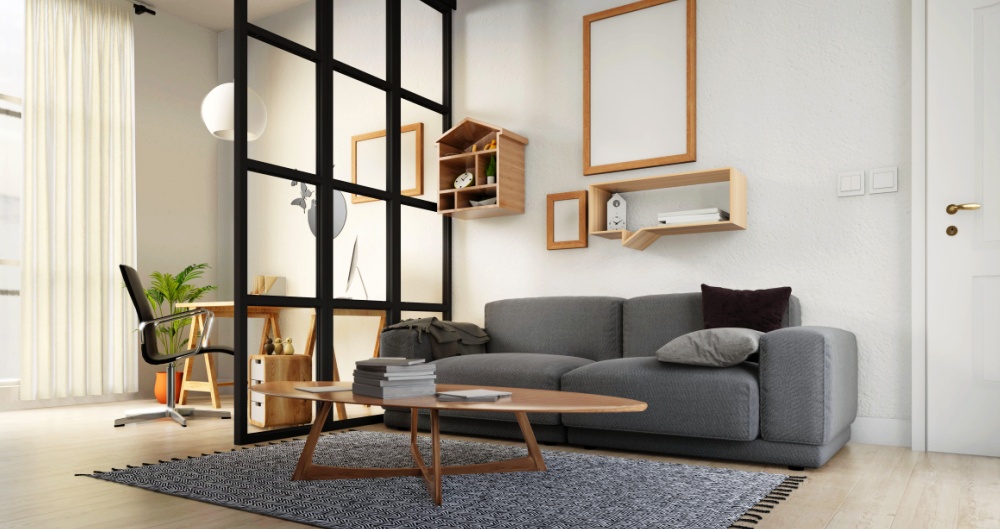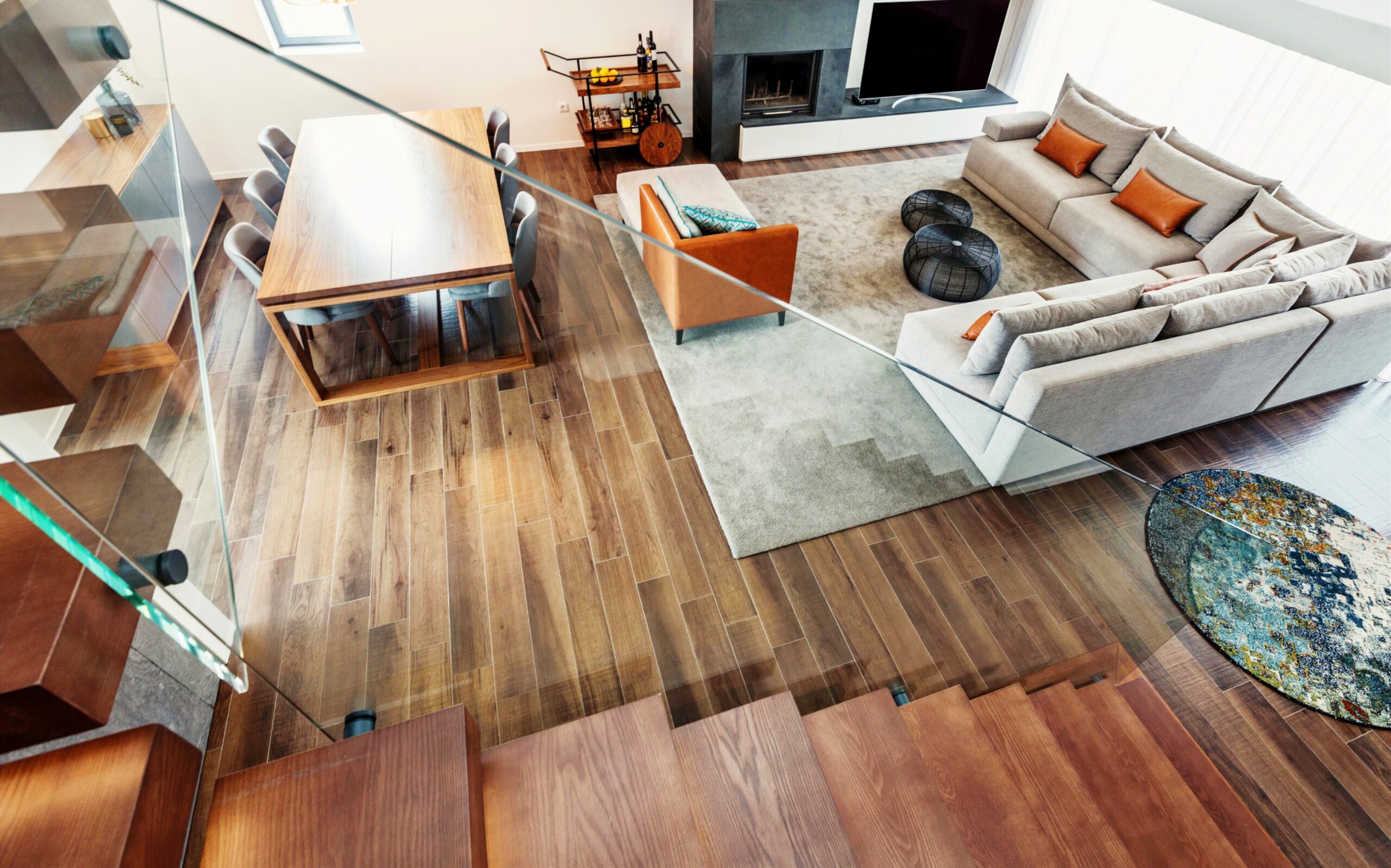How to divide a room without walls
Despite dominating interior design for decades, the open-plan concept has long since lost its charm for homeowners and office workers, as balancing private and shared spaces is key to maintaining wellbeing and enhancing productivity.
From studio apartments to new build houses, public buildings to commercial offices, most people prefer to have designated areas for different activities rather than one big room – without closing them all off entirely.
Whether you want to optimise your office or modernise your home, you might be wondering: ‘How can I divide a room without building new walls?’
After all, constructing new walls can be costly, time-consuming, and subject to building regulations – not to mention potentially blocking natural light sources. However, there are several ways to split up an open-concept space into smaller defined areas without sacrificing the flow or functionality of the overall space.
So, if you’re looking for creative room divider ideas and tips on how to make your current space work twice as hard, here are 8 ways to divide a room without walls!
Divide a room with furniture
Depending on the level of separation you want to achieve between different spaces, it’s often easier to divide an open-plan room simply by arranging the furniture in certain ways.
For example, you can position sofas and chairs around a rug to create a living room or break room area, or install a breakfast bar to divide a lounge area from the kitchen.
If you would rather form a more distinct barrier to delineate areas for different purposes, here are some top tips:
1) Console tables
A console is a long, low, and narrow table, typically containing an open shelf below and/or small drawers within the top part.
This piece of furniture is perfect for placing behind a couch to hide the back of the sofa and indicate that the space beyond is a separate room, or for dividing a part of the room for recreation or relaxation from another part of the room for work.
You’ll also get a little extra storage from the table without it looking too cluttered, as you can display a few decorative items to add some style and personality.
2) Bookshelves
Whether tall, low, or multi-level, bookcases are also a great way to double up on a room divider and storage solution.
However, if they’re solid bookshelves, you’ll need to consider how this will affect the lighting in each part of the room – and if the bookcase is more than a few shelves tall, it must be secured to a wall on at least one side so it doesn’t tip over.
Safety is paramount, so you should also be careful not to overload the shelves with heavy books or fragile décor.
3) Open shelving units
A free-standing shelving unit with open shelves, especially the kind with a cube design, is a popular alternative.
Though you can also use them to store books and other physical media, such as vinyl, CDs, or DVDs, the open storage allows you to form a physical barrier between two parts of a room without completely blocking the light.
This type of shelving is great for curating a visual display of items such as décor objects, artworks, or houseplants.
4) Hanging or potted plants
Speaking of which – if you enjoy greenery, why not use plants for a visually appealing divider that benefits both sides?
A row of tall potted plants or hanging plants with a waterfall of leaves can keep two halves of a space separate from each other, while each area still feels open and airy because of the bright natural colours and connection to the outdoors.
Of course, lots of real plants can be difficult to maintain, but you can always opt for realistic-looking fake ones.
Temporary room dividers
The issue that some people may have with using pieces of furniture is that they can be bulky and take up a significant amount of room, while still leaving gaps between or above them.
If you want a room divider that’s more solid while taking up less floor space, without the permanence of constructing a new wall or half-wall, there are several options.
Here are some of the best ways to create a temporary wall that can be easily moved to transition between spaces:
5) Curtains
Affordable and easy to install, curtains have more uses than covering a window or surrounding a luxurious bed.
Where standing dividers may not be practical, soft hanging partitions can create visual privacy while also adding texture and colour. Floor-to-ceiling drapes or thin and floaty voiles – you can choose the fabric style and opacity that suits your needs.
The downside, of course, is that even thick curtains won’t block sound from travelling between the spaces.
6) Folding screens
Originating in China over 2,000 years ago and imported to Europe by the 1500s, you can’t go wrong with a classic screen.
Though there are varying traditional styles of free-standing screens, hinged folding screens are especially practical as a lightweight solution that can fully open to divide rooms and fold shut to re-join the spaces if needed.
They come in a wide range of materials, and can also display beautiful patterns and artwork when the panels are open.
7) Sliding doors
Maybe you don’t have much space to spare, but you would like to close off part of a room with its own door for access.
Much like folding screens, sliding doors have been around for many centuries, but modern designs have perfected the mechanisms and material choices to allow the ultimate functionality with a minimal footprint.
Sliding doors can be mounted using a track in the floor or top-hung from the ceiling, or both at the same time.
8) Removeable partitions
Last but not least, the best solution for a compact room divider that adds style and enhances light flow while muffling sound transmission and forming a distinctive barrier between areas – glass partitions.
Partition walls made from toughened glass are durable and straightforward to install, and can be customised to fit your space precisely. They can be partially or totally frosted for privacy, and acoustic glass is also available to muffle sound.
You can opt for industrial-style framed glass partitions that recreate the classic Crittall look or choose a frameless system that keeps things sleek and low-impact. If you would still like a partition wall with a sliding door, this is possible, too, thanks to glass partitions with glass doors!
Contact us for glass partitions
If you’re interested in a bespoke glass partition as a stylish and flexible room divider, for any purpose, then you’re in the right place at Glass Interiors. Browse our website to find out more about what we do, or get in touch with our team.
To reach us with any queries, please call 0203 793 5455 or email info@glass-interiors.co.uk – we can discuss your glass room divider needs and provide a competitively-priced quote.






